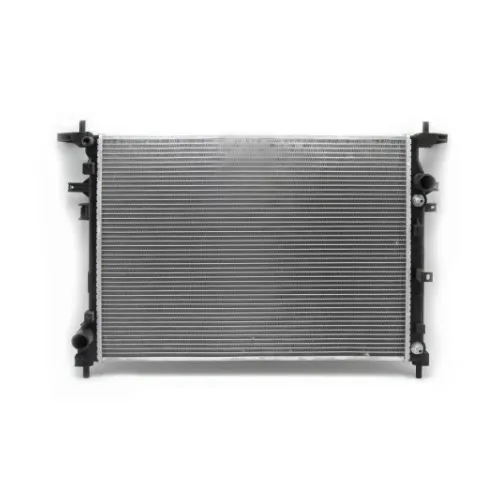Understanding the Impact of Corrosion on Automotive Aluminum Plastic Radiators
2024-11-28
Aluminum plastic radiators have become the preferred choice for many modern vehicles due to their lightweight construction, superior heat transfer properties, and cost-effectiveness. However, like all materials used in automotive systems, aluminum plastic radiators are not immune to the destructive forces of corrosion. Corrosion can have a significant impact on the performance and lifespan of these radiators, leading to reduced efficiency, costly repairs, and potential system failure. In this blog, we explore how corrosion affects automotive aluminum plastic radiators, the causes of corrosion, and the ways to mitigate its impact.
What Are Aluminum Plastic Radiators?
Aluminum plastic radiators are composite radiators commonly used in automotive cooling systems. They are made from aluminum for the core and plastic for the tanks and end caps. The aluminum core is designed to transfer heat efficiently, while the plastic components are lightweight and resistant to cracking under pressure.
The combination of aluminum and plastic offers several benefits:
- Lightweight: Aluminum’s low weight helps reduce the overall mass of the vehicle, improving fuel efficiency and performance.
- Efficient Heat Transfer: Aluminum has excellent thermal conductivity, helping to dissipate heat effectively from the engine.
- Cost-Effective: Compared to traditional copper-brass radiators, aluminum plastic radiators are often more affordable, both in terms of manufacturing and replacement.
Despite these advantages, corrosion remains a major challenge for the long-term performance of these radiators.
How Does Corrosion Affect Aluminum Plastic Radiators?
Corrosion in automotive aluminum plastic radiators can manifest in several forms, including pitting, galvanic corrosion, frost damage, and stress corrosion cracking. Each type of corrosion impacts the radiator’s performance in different ways:
1. Pitting Corrosion:
Pitting corrosion occurs when small holes or pits form in the aluminum surface, usually due to the presence of electrolytes like water or salt. These pits can gradually weaken the radiator, leading to coolant leaks, reduced cooling efficiency, and potentially catastrophic failure. Over time, the accumulation of pits can also cause increased wear on the radiator’s plastic components.
2. Galvanic Corrosion:
When aluminum comes into contact with dissimilar metals, such as the copper used in some radiator components, a galvanic reaction can occur. This reaction creates an electrical charge that accelerates the breakdown of aluminum, weakening the radiator and reducing its ability to effectively dissipate heat. In aluminum plastic radiators, galvanic corrosion often occurs between the aluminum core and the metal connections or fittings used to connect the radiator to the cooling system.
3. Frost Damage:
Frost damage is a common problem in colder climates, where the temperature can drop below freezing. When water trapped inside the radiator freezes, it expands and can cause cracks or fractures in the aluminum or plastic components. This damage compromises the radiator's ability to perform effectively, leading to coolant leaks and a significant decrease in cooling efficiency.
4. Stress Corrosion Cracking (SCC):
Stress corrosion cracking occurs when the aluminum is exposed to both mechanical stress and corrosive elements (such as moisture and salts). The combination of these factors causes cracks to form in the material, which can eventually lead to leakage or complete failure of the radiator. SCC is often exacerbated by high-pressure environments, such as those found in automotive cooling systems.
Causes of Corrosion in Automotive Aluminum Plastic Radiators
Several factors contribute to the corrosion of aluminum plastic radiators, including:
1. Exposure to Corrosive Elements:
Road salt, chemicals, and even the air itself can expose the radiator to corrosive agents. In areas where vehicles are exposed to heavy rain or snow, the presence of salt and moisture accelerates the corrosion process.
2. Coolant Quality:
The type of coolant used in the radiator can play a crucial role in corrosion resistance. Low-quality coolant or coolant that is not properly mixed with the right amount of antifreeze can promote corrosion. Coolants that are too acidic or too alkaline can also damage the radiator’s surface.
3. High Operating Temperatures:
Operating at higher engine temperatures or using the radiator under extreme load conditions increases the likelihood of corrosion. In these conditions, the materials used in the radiator may be more susceptible to chemical reactions that lead to degradation.
4. Improper Maintenance:
Failure to flush and replace the coolant periodically can lead to the buildup of corrosive substances, which accelerate the degradation of both the aluminum and plastic components of the radiator. Over time, dirt, debris, and scale can accumulate inside the radiator, contributing to the formation of corrosion.
How Corrosion Affects Performance
The performance of a radiator is closely tied to its ability to effectively transfer heat from the engine to the air. When corrosion sets in, it compromises this heat exchange process in several ways:
1. Reduced Heat Transfer Efficiency:
Corroded aluminum surfaces have a reduced ability to transfer heat effectively, leading to an increase in engine temperature. This can cause the engine to overheat, which may result in engine damage or failure.
2. Coolant Leaks:
Pitting and cracking due to corrosion can cause coolant leaks, which reduces the amount of coolant available to circulate through the engine. This can lead to overheating and eventually cause the engine to seize.
3. Increased Maintenance Costs:
Corroded radiators require frequent repairs or even complete replacement. The longer corrosion is allowed to progress, the more expensive it becomes to restore the radiator to full functionality, which can increase the vehicle’s maintenance costs.
Preventing and Mitigating Corrosion
1. Regular Maintenance:
Regularly inspecting the radiator for signs of corrosion, such as discoloration, leaks, or unusual wear on the plastic components, can help identify issues early before they cause significant damage.
2. Using High-Quality Coolant:
Ensure that the coolant used in the radiator is of high quality and is properly mixed with the right amount of antifreeze. Using corrosion inhibitors in the coolant can help protect the aluminum from degradation.
3. Protective Coatings:
Some radiators come with protective coatings that help prevent corrosion. These coatings act as a barrier between the aluminum and external corrosive agents, prolonging the life of the radiator.
4. Proper Storage:
If the vehicle is going to be stored for extended periods, ensure that the cooling system is properly flushed and filled with appropriate coolant to prevent corrosion from occurring during the off-season.
Corrosion is one of the primary factors that can reduce the performance and lifespan of automotive aluminum plastic radiators. While the lightweight and efficient design of these radiators makes them an excellent choice for modern vehicles, corrosion can significantly impact their heat transfer efficiency, structural integrity, and overall function. Regular maintenance, proper coolant management, and protective measures are essential for minimizing corrosion and ensuring that the radiator continues to perform optimally throughout the life of the vehicle. Understanding the effects of corrosion on aluminum plastic radiators is crucial for vehicle owners and maintenance professionals, allowing them to take proactive steps to preserve radiator performance and avoid costly repairs.



